Workplace Simulated Scenario (Case Study) - Desklib
VerifiedAdded on 2023/06/07
|11
|2661
|277
AI Summary
Read this Workplace Simulated Scenario (Case Study) and learn about nursing and midwifery board of Australia, recency of practice, professional and collaborative practice domain, privacy act, euthanasia and more. Get access to solved assignments, essays, dissertation and more at Desklib.
Contribute Materials
Your contribution can guide someone’s learning journey. Share your
documents today.
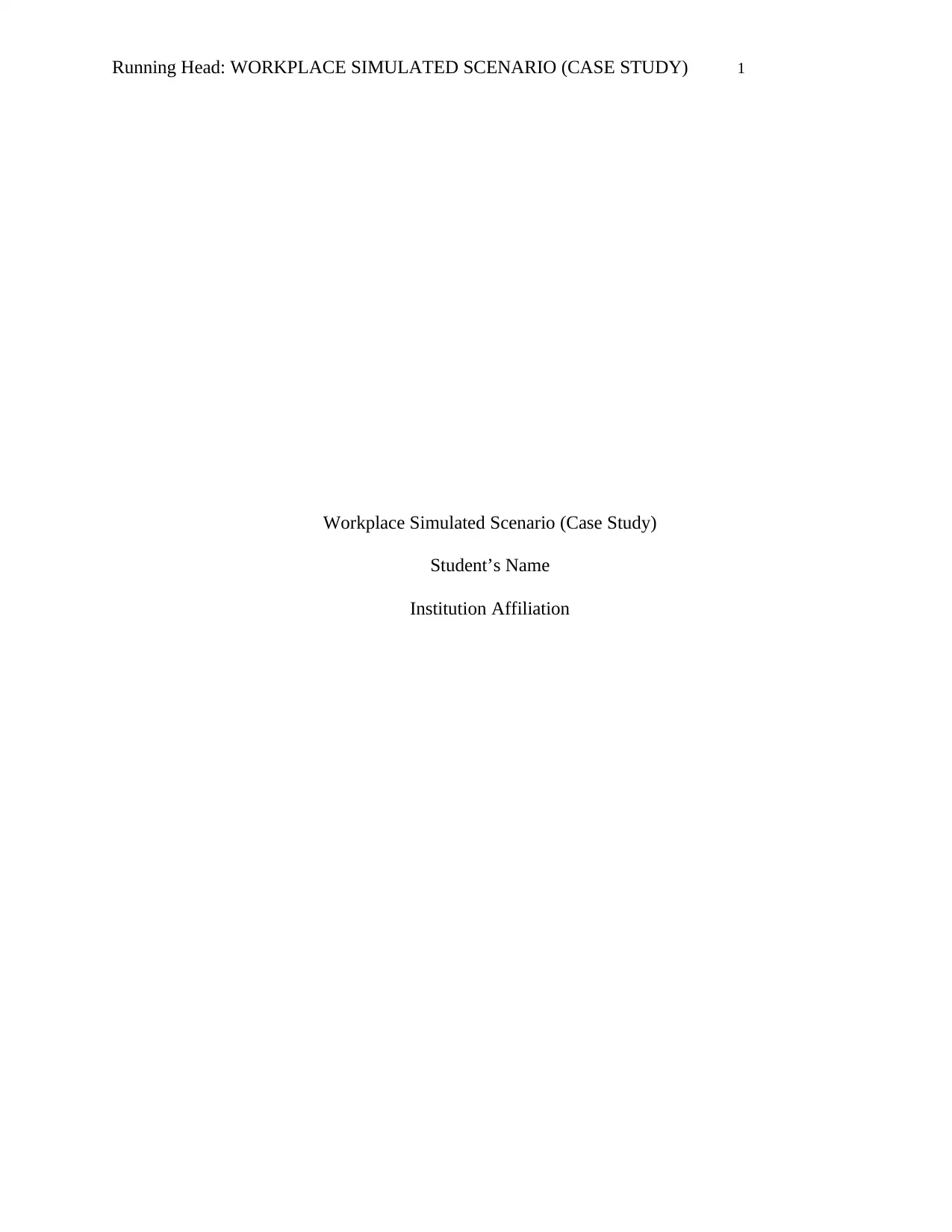
Running Head: WORKPLACE SIMULATED SCENARIO (CASE STUDY) 1
Workplace Simulated Scenario (Case Study)
Student’s Name
Institution Affiliation
Workplace Simulated Scenario (Case Study)
Student’s Name
Institution Affiliation
Secure Best Marks with AI Grader
Need help grading? Try our AI Grader for instant feedback on your assignments.
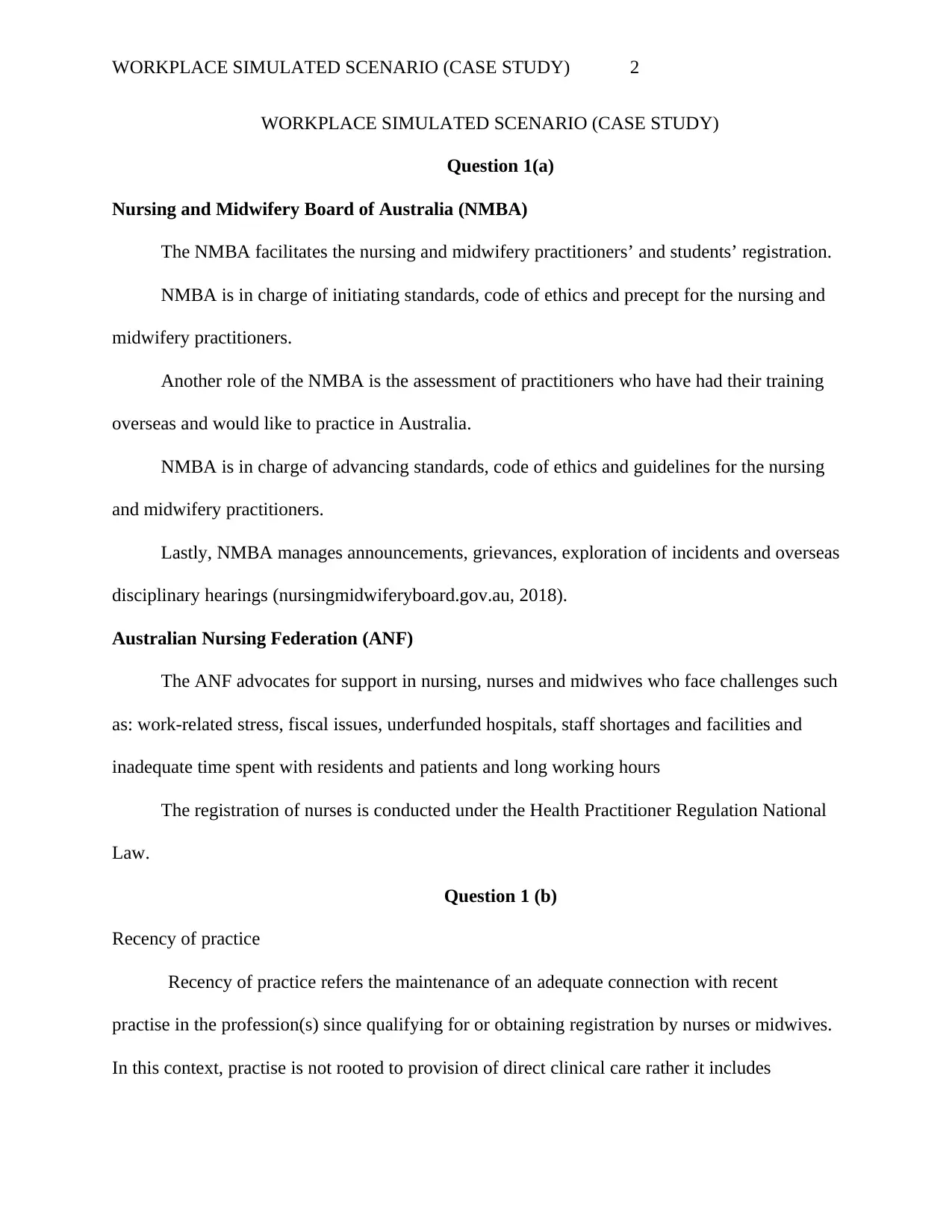
WORKPLACE SIMULATED SCENARIO (CASE STUDY) 2
WORKPLACE SIMULATED SCENARIO (CASE STUDY)
Question 1(a)
Nursing and Midwifery Board of Australia (NMBA)
The NMBA facilitates the nursing and midwifery practitioners’ and students’ registration.
NMBA is in charge of initiating standards, code of ethics and precept for the nursing and
midwifery practitioners.
Another role of the NMBA is the assessment of practitioners who have had their training
overseas and would like to practice in Australia.
NMBA is in charge of advancing standards, code of ethics and guidelines for the nursing
and midwifery practitioners.
Lastly, NMBA manages announcements, grievances, exploration of incidents and overseas
disciplinary hearings (nursingmidwiferyboard.gov.au, 2018).
Australian Nursing Federation (ANF)
The ANF advocates for support in nursing, nurses and midwives who face challenges such
as: work-related stress, fiscal issues, underfunded hospitals, staff shortages and facilities and
inadequate time spent with residents and patients and long working hours
The registration of nurses is conducted under the Health Practitioner Regulation National
Law.
Question 1 (b)
Recency of practice
Recency of practice refers the maintenance of an adequate connection with recent
practise in the profession(s) since qualifying for or obtaining registration by nurses or midwives.
In this context, practise is not rooted to provision of direct clinical care rather it includes
WORKPLACE SIMULATED SCENARIO (CASE STUDY)
Question 1(a)
Nursing and Midwifery Board of Australia (NMBA)
The NMBA facilitates the nursing and midwifery practitioners’ and students’ registration.
NMBA is in charge of initiating standards, code of ethics and precept for the nursing and
midwifery practitioners.
Another role of the NMBA is the assessment of practitioners who have had their training
overseas and would like to practice in Australia.
NMBA is in charge of advancing standards, code of ethics and guidelines for the nursing
and midwifery practitioners.
Lastly, NMBA manages announcements, grievances, exploration of incidents and overseas
disciplinary hearings (nursingmidwiferyboard.gov.au, 2018).
Australian Nursing Federation (ANF)
The ANF advocates for support in nursing, nurses and midwives who face challenges such
as: work-related stress, fiscal issues, underfunded hospitals, staff shortages and facilities and
inadequate time spent with residents and patients and long working hours
The registration of nurses is conducted under the Health Practitioner Regulation National
Law.
Question 1 (b)
Recency of practice
Recency of practice refers the maintenance of an adequate connection with recent
practise in the profession(s) since qualifying for or obtaining registration by nurses or midwives.
In this context, practise is not rooted to provision of direct clinical care rather it includes
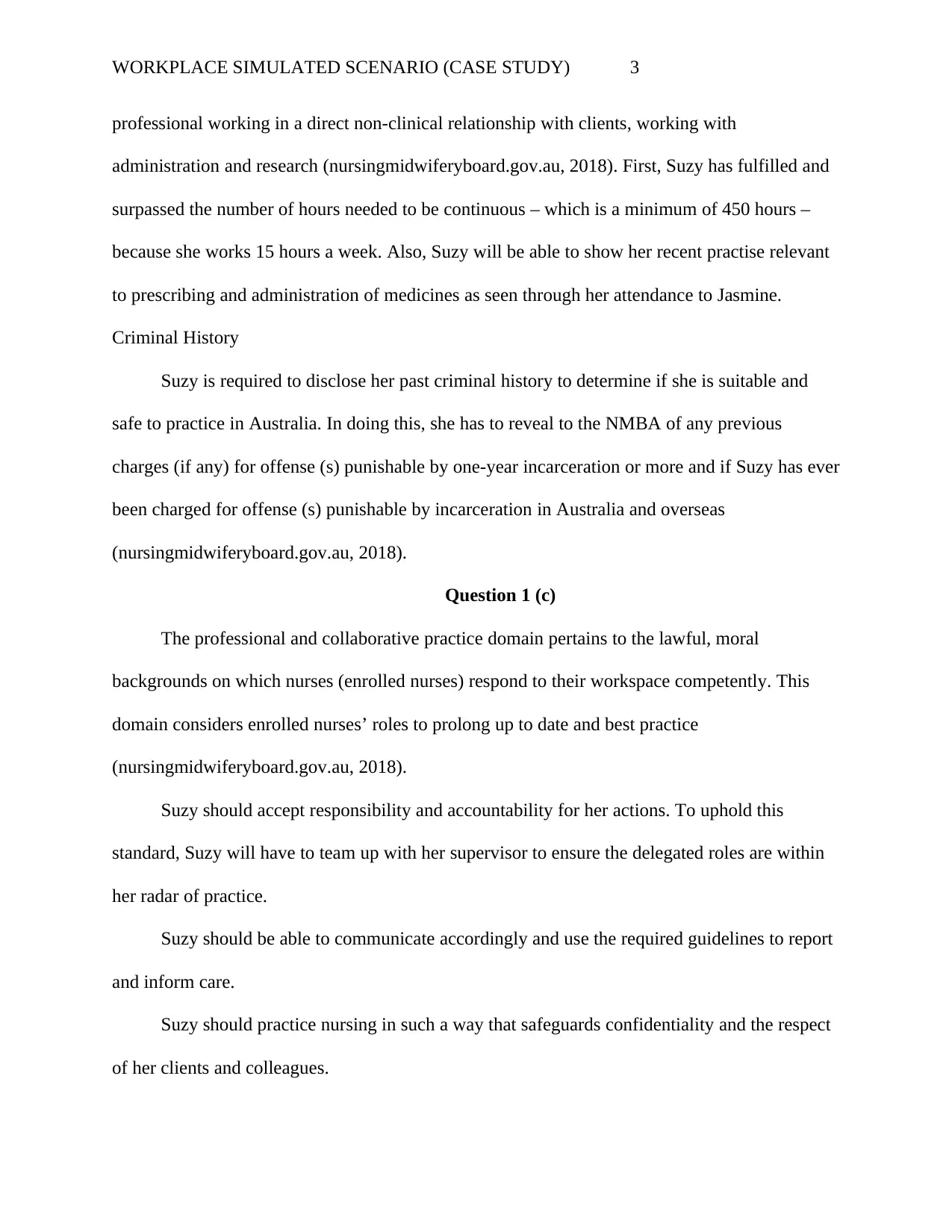
WORKPLACE SIMULATED SCENARIO (CASE STUDY) 3
professional working in a direct non-clinical relationship with clients, working with
administration and research (nursingmidwiferyboard.gov.au, 2018). First, Suzy has fulfilled and
surpassed the number of hours needed to be continuous – which is a minimum of 450 hours –
because she works 15 hours a week. Also, Suzy will be able to show her recent practise relevant
to prescribing and administration of medicines as seen through her attendance to Jasmine.
Criminal History
Suzy is required to disclose her past criminal history to determine if she is suitable and
safe to practice in Australia. In doing this, she has to reveal to the NMBA of any previous
charges (if any) for offense (s) punishable by one-year incarceration or more and if Suzy has ever
been charged for offense (s) punishable by incarceration in Australia and overseas
(nursingmidwiferyboard.gov.au, 2018).
Question 1 (c)
The professional and collaborative practice domain pertains to the lawful, moral
backgrounds on which nurses (enrolled nurses) respond to their workspace competently. This
domain considers enrolled nurses’ roles to prolong up to date and best practice
(nursingmidwiferyboard.gov.au, 2018).
Suzy should accept responsibility and accountability for her actions. To uphold this
standard, Suzy will have to team up with her supervisor to ensure the delegated roles are within
her radar of practice.
Suzy should be able to communicate accordingly and use the required guidelines to report
and inform care.
Suzy should practice nursing in such a way that safeguards confidentiality and the respect
of her clients and colleagues.
professional working in a direct non-clinical relationship with clients, working with
administration and research (nursingmidwiferyboard.gov.au, 2018). First, Suzy has fulfilled and
surpassed the number of hours needed to be continuous – which is a minimum of 450 hours –
because she works 15 hours a week. Also, Suzy will be able to show her recent practise relevant
to prescribing and administration of medicines as seen through her attendance to Jasmine.
Criminal History
Suzy is required to disclose her past criminal history to determine if she is suitable and
safe to practice in Australia. In doing this, she has to reveal to the NMBA of any previous
charges (if any) for offense (s) punishable by one-year incarceration or more and if Suzy has ever
been charged for offense (s) punishable by incarceration in Australia and overseas
(nursingmidwiferyboard.gov.au, 2018).
Question 1 (c)
The professional and collaborative practice domain pertains to the lawful, moral
backgrounds on which nurses (enrolled nurses) respond to their workspace competently. This
domain considers enrolled nurses’ roles to prolong up to date and best practice
(nursingmidwiferyboard.gov.au, 2018).
Suzy should accept responsibility and accountability for her actions. To uphold this
standard, Suzy will have to team up with her supervisor to ensure the delegated roles are within
her radar of practice.
Suzy should be able to communicate accordingly and use the required guidelines to report
and inform care.
Suzy should practice nursing in such a way that safeguards confidentiality and the respect
of her clients and colleagues.
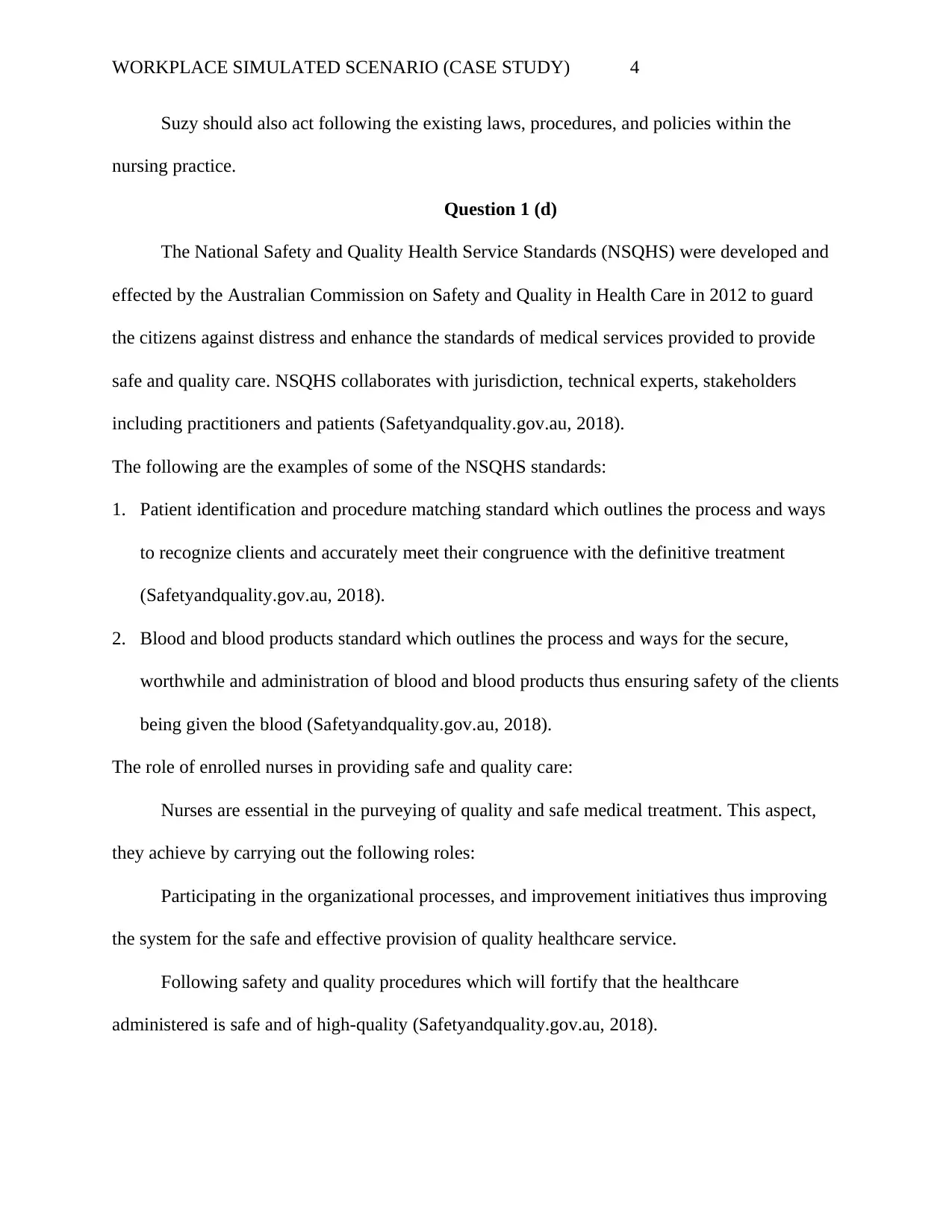
WORKPLACE SIMULATED SCENARIO (CASE STUDY) 4
Suzy should also act following the existing laws, procedures, and policies within the
nursing practice.
Question 1 (d)
The National Safety and Quality Health Service Standards (NSQHS) were developed and
effected by the Australian Commission on Safety and Quality in Health Care in 2012 to guard
the citizens against distress and enhance the standards of medical services provided to provide
safe and quality care. NSQHS collaborates with jurisdiction, technical experts, stakeholders
including practitioners and patients (Safetyandquality.gov.au, 2018).
The following are the examples of some of the NSQHS standards:
1. Patient identification and procedure matching standard which outlines the process and ways
to recognize clients and accurately meet their congruence with the definitive treatment
(Safetyandquality.gov.au, 2018).
2. Blood and blood products standard which outlines the process and ways for the secure,
worthwhile and administration of blood and blood products thus ensuring safety of the clients
being given the blood (Safetyandquality.gov.au, 2018).
The role of enrolled nurses in providing safe and quality care:
Nurses are essential in the purveying of quality and safe medical treatment. This aspect,
they achieve by carrying out the following roles:
Participating in the organizational processes, and improvement initiatives thus improving
the system for the safe and effective provision of quality healthcare service.
Following safety and quality procedures which will fortify that the healthcare
administered is safe and of high-quality (Safetyandquality.gov.au, 2018).
Suzy should also act following the existing laws, procedures, and policies within the
nursing practice.
Question 1 (d)
The National Safety and Quality Health Service Standards (NSQHS) were developed and
effected by the Australian Commission on Safety and Quality in Health Care in 2012 to guard
the citizens against distress and enhance the standards of medical services provided to provide
safe and quality care. NSQHS collaborates with jurisdiction, technical experts, stakeholders
including practitioners and patients (Safetyandquality.gov.au, 2018).
The following are the examples of some of the NSQHS standards:
1. Patient identification and procedure matching standard which outlines the process and ways
to recognize clients and accurately meet their congruence with the definitive treatment
(Safetyandquality.gov.au, 2018).
2. Blood and blood products standard which outlines the process and ways for the secure,
worthwhile and administration of blood and blood products thus ensuring safety of the clients
being given the blood (Safetyandquality.gov.au, 2018).
The role of enrolled nurses in providing safe and quality care:
Nurses are essential in the purveying of quality and safe medical treatment. This aspect,
they achieve by carrying out the following roles:
Participating in the organizational processes, and improvement initiatives thus improving
the system for the safe and effective provision of quality healthcare service.
Following safety and quality procedures which will fortify that the healthcare
administered is safe and of high-quality (Safetyandquality.gov.au, 2018).
Secure Best Marks with AI Grader
Need help grading? Try our AI Grader for instant feedback on your assignments.
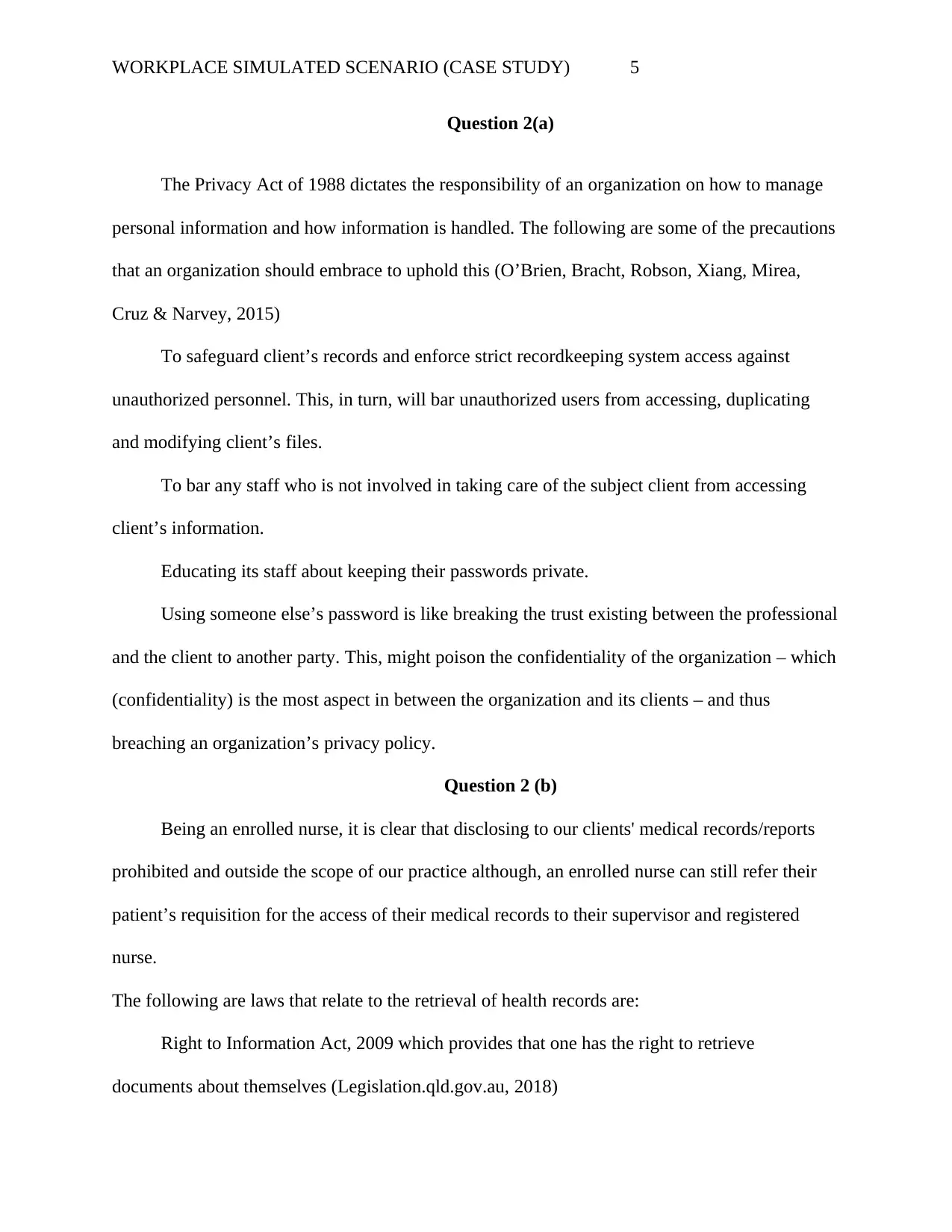
WORKPLACE SIMULATED SCENARIO (CASE STUDY) 5
Question 2(a)
The Privacy Act of 1988 dictates the responsibility of an organization on how to manage
personal information and how information is handled. The following are some of the precautions
that an organization should embrace to uphold this (O’Brien, Bracht, Robson, Xiang, Mirea,
Cruz & Narvey, 2015)
To safeguard client’s records and enforce strict recordkeeping system access against
unauthorized personnel. This, in turn, will bar unauthorized users from accessing, duplicating
and modifying client’s files.
To bar any staff who is not involved in taking care of the subject client from accessing
client’s information.
Educating its staff about keeping their passwords private.
Using someone else’s password is like breaking the trust existing between the professional
and the client to another party. This, might poison the confidentiality of the organization – which
(confidentiality) is the most aspect in between the organization and its clients – and thus
breaching an organization’s privacy policy.
Question 2 (b)
Being an enrolled nurse, it is clear that disclosing to our clients' medical records/reports
prohibited and outside the scope of our practice although, an enrolled nurse can still refer their
patient’s requisition for the access of their medical records to their supervisor and registered
nurse.
The following are laws that relate to the retrieval of health records are:
Right to Information Act, 2009 which provides that one has the right to retrieve
documents about themselves (Legislation.qld.gov.au, 2018)
Question 2(a)
The Privacy Act of 1988 dictates the responsibility of an organization on how to manage
personal information and how information is handled. The following are some of the precautions
that an organization should embrace to uphold this (O’Brien, Bracht, Robson, Xiang, Mirea,
Cruz & Narvey, 2015)
To safeguard client’s records and enforce strict recordkeeping system access against
unauthorized personnel. This, in turn, will bar unauthorized users from accessing, duplicating
and modifying client’s files.
To bar any staff who is not involved in taking care of the subject client from accessing
client’s information.
Educating its staff about keeping their passwords private.
Using someone else’s password is like breaking the trust existing between the professional
and the client to another party. This, might poison the confidentiality of the organization – which
(confidentiality) is the most aspect in between the organization and its clients – and thus
breaching an organization’s privacy policy.
Question 2 (b)
Being an enrolled nurse, it is clear that disclosing to our clients' medical records/reports
prohibited and outside the scope of our practice although, an enrolled nurse can still refer their
patient’s requisition for the access of their medical records to their supervisor and registered
nurse.
The following are laws that relate to the retrieval of health records are:
Right to Information Act, 2009 which provides that one has the right to retrieve
documents about themselves (Legislation.qld.gov.au, 2018)
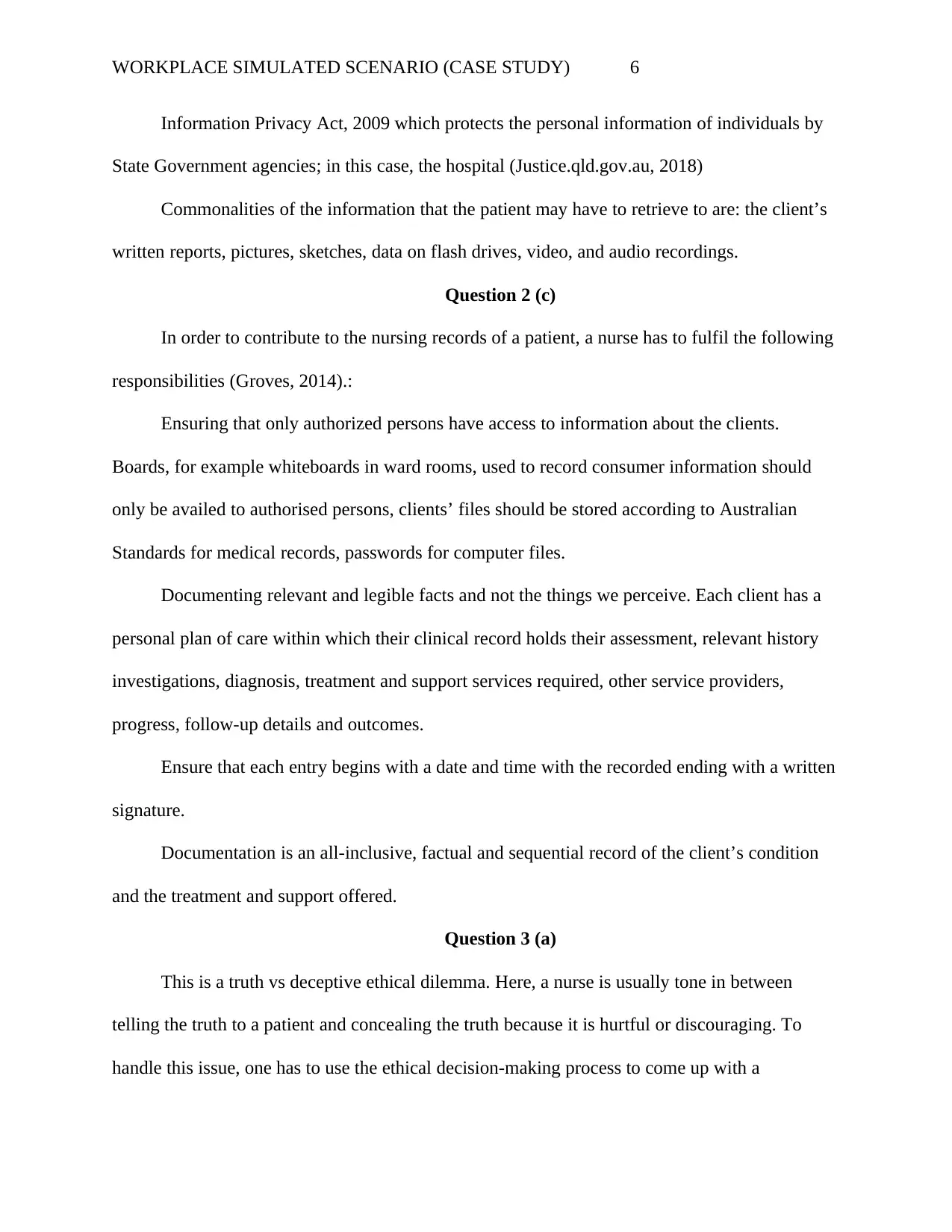
WORKPLACE SIMULATED SCENARIO (CASE STUDY) 6
Information Privacy Act, 2009 which protects the personal information of individuals by
State Government agencies; in this case, the hospital (Justice.qld.gov.au, 2018)
Commonalities of the information that the patient may have to retrieve to are: the client’s
written reports, pictures, sketches, data on flash drives, video, and audio recordings.
Question 2 (c)
In order to contribute to the nursing records of a patient, a nurse has to fulfil the following
responsibilities (Groves, 2014).:
Ensuring that only authorized persons have access to information about the clients.
Boards, for example whiteboards in ward rooms, used to record consumer information should
only be availed to authorised persons, clients’ files should be stored according to Australian
Standards for medical records, passwords for computer files.
Documenting relevant and legible facts and not the things we perceive. Each client has a
personal plan of care within which their clinical record holds their assessment, relevant history
investigations, diagnosis, treatment and support services required, other service providers,
progress, follow-up details and outcomes.
Ensure that each entry begins with a date and time with the recorded ending with a written
signature.
Documentation is an all-inclusive, factual and sequential record of the client’s condition
and the treatment and support offered.
Question 3 (a)
This is a truth vs deceptive ethical dilemma. Here, a nurse is usually tone in between
telling the truth to a patient and concealing the truth because it is hurtful or discouraging. To
handle this issue, one has to use the ethical decision-making process to come up with a
Information Privacy Act, 2009 which protects the personal information of individuals by
State Government agencies; in this case, the hospital (Justice.qld.gov.au, 2018)
Commonalities of the information that the patient may have to retrieve to are: the client’s
written reports, pictures, sketches, data on flash drives, video, and audio recordings.
Question 2 (c)
In order to contribute to the nursing records of a patient, a nurse has to fulfil the following
responsibilities (Groves, 2014).:
Ensuring that only authorized persons have access to information about the clients.
Boards, for example whiteboards in ward rooms, used to record consumer information should
only be availed to authorised persons, clients’ files should be stored according to Australian
Standards for medical records, passwords for computer files.
Documenting relevant and legible facts and not the things we perceive. Each client has a
personal plan of care within which their clinical record holds their assessment, relevant history
investigations, diagnosis, treatment and support services required, other service providers,
progress, follow-up details and outcomes.
Ensure that each entry begins with a date and time with the recorded ending with a written
signature.
Documentation is an all-inclusive, factual and sequential record of the client’s condition
and the treatment and support offered.
Question 3 (a)
This is a truth vs deceptive ethical dilemma. Here, a nurse is usually tone in between
telling the truth to a patient and concealing the truth because it is hurtful or discouraging. To
handle this issue, one has to use the ethical decision-making process to come up with a
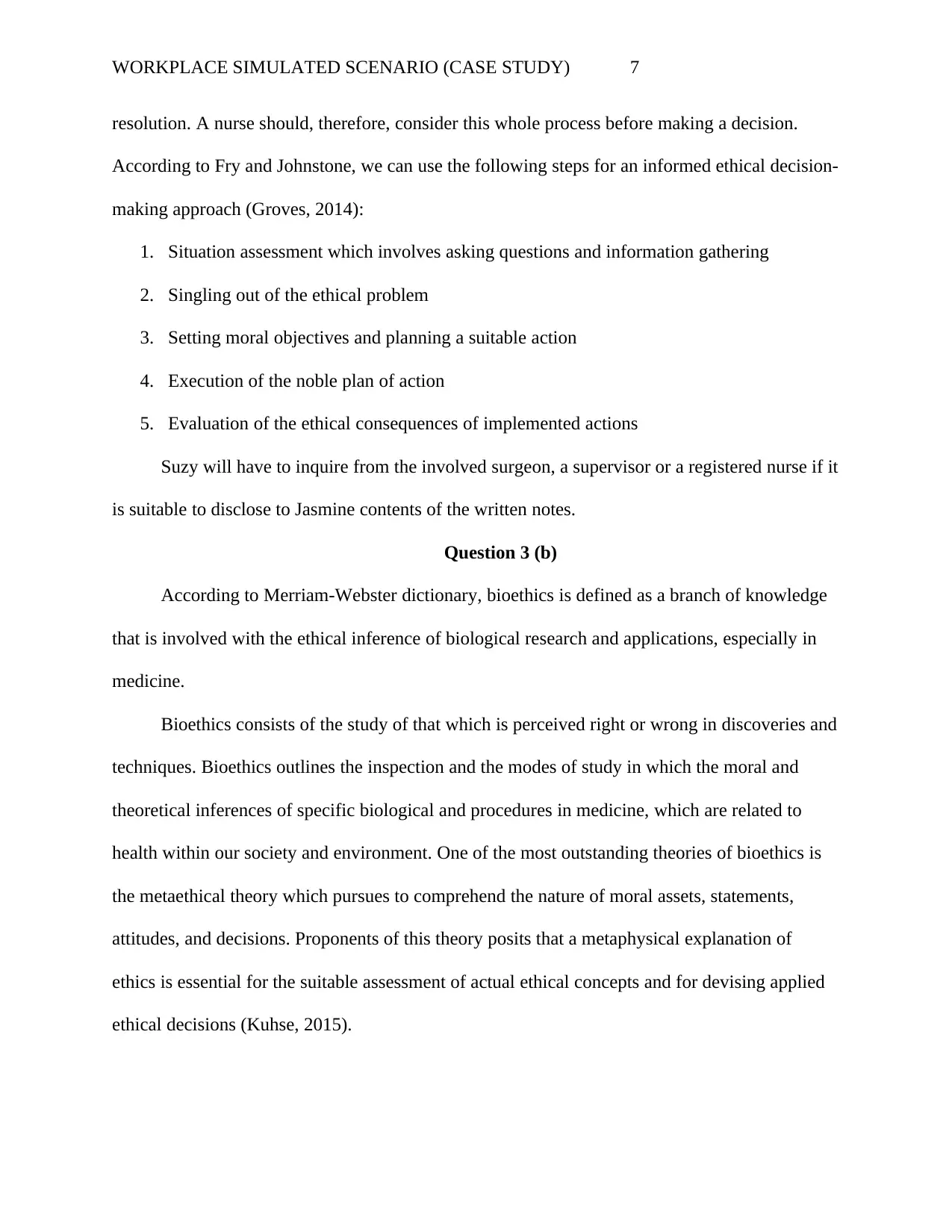
WORKPLACE SIMULATED SCENARIO (CASE STUDY) 7
resolution. A nurse should, therefore, consider this whole process before making a decision.
According to Fry and Johnstone, we can use the following steps for an informed ethical decision-
making approach (Groves, 2014):
1. Situation assessment which involves asking questions and information gathering
2. Singling out of the ethical problem
3. Setting moral objectives and planning a suitable action
4. Execution of the noble plan of action
5. Evaluation of the ethical consequences of implemented actions
Suzy will have to inquire from the involved surgeon, a supervisor or a registered nurse if it
is suitable to disclose to Jasmine contents of the written notes.
Question 3 (b)
According to Merriam-Webster dictionary, bioethics is defined as a branch of knowledge
that is involved with the ethical inference of biological research and applications, especially in
medicine.
Bioethics consists of the study of that which is perceived right or wrong in discoveries and
techniques. Bioethics outlines the inspection and the modes of study in which the moral and
theoretical inferences of specific biological and procedures in medicine, which are related to
health within our society and environment. One of the most outstanding theories of bioethics is
the metaethical theory which pursues to comprehend the nature of moral assets, statements,
attitudes, and decisions. Proponents of this theory posits that a metaphysical explanation of
ethics is essential for the suitable assessment of actual ethical concepts and for devising applied
ethical decisions (Kuhse, 2015).
resolution. A nurse should, therefore, consider this whole process before making a decision.
According to Fry and Johnstone, we can use the following steps for an informed ethical decision-
making approach (Groves, 2014):
1. Situation assessment which involves asking questions and information gathering
2. Singling out of the ethical problem
3. Setting moral objectives and planning a suitable action
4. Execution of the noble plan of action
5. Evaluation of the ethical consequences of implemented actions
Suzy will have to inquire from the involved surgeon, a supervisor or a registered nurse if it
is suitable to disclose to Jasmine contents of the written notes.
Question 3 (b)
According to Merriam-Webster dictionary, bioethics is defined as a branch of knowledge
that is involved with the ethical inference of biological research and applications, especially in
medicine.
Bioethics consists of the study of that which is perceived right or wrong in discoveries and
techniques. Bioethics outlines the inspection and the modes of study in which the moral and
theoretical inferences of specific biological and procedures in medicine, which are related to
health within our society and environment. One of the most outstanding theories of bioethics is
the metaethical theory which pursues to comprehend the nature of moral assets, statements,
attitudes, and decisions. Proponents of this theory posits that a metaphysical explanation of
ethics is essential for the suitable assessment of actual ethical concepts and for devising applied
ethical decisions (Kuhse, 2015).
Paraphrase This Document
Need a fresh take? Get an instant paraphrase of this document with our AI Paraphraser
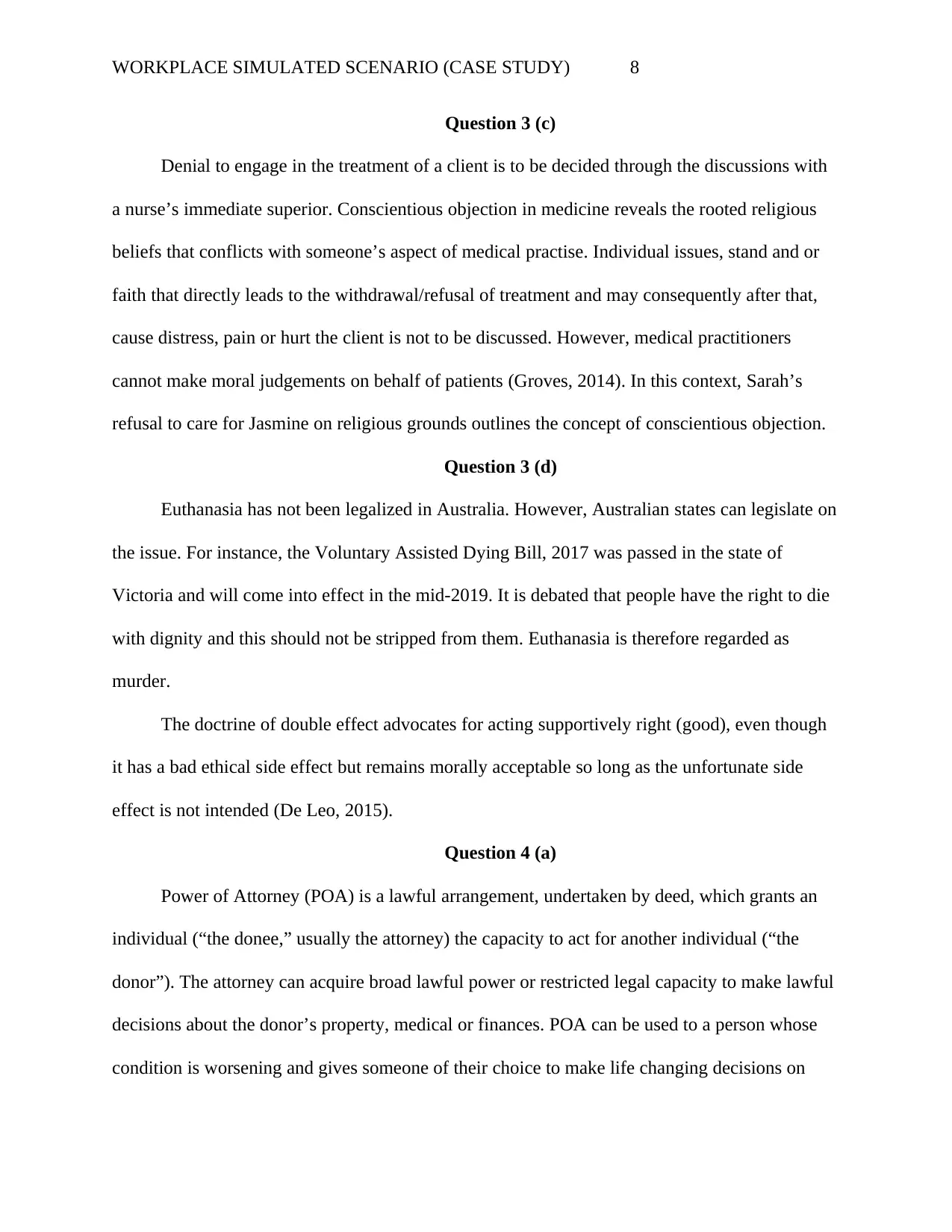
WORKPLACE SIMULATED SCENARIO (CASE STUDY) 8
Question 3 (c)
Denial to engage in the treatment of a client is to be decided through the discussions with
a nurse’s immediate superior. Conscientious objection in medicine reveals the rooted religious
beliefs that conflicts with someone’s aspect of medical practise. Individual issues, stand and or
faith that directly leads to the withdrawal/refusal of treatment and may consequently after that,
cause distress, pain or hurt the client is not to be discussed. However, medical practitioners
cannot make moral judgements on behalf of patients (Groves, 2014). In this context, Sarah’s
refusal to care for Jasmine on religious grounds outlines the concept of conscientious objection.
Question 3 (d)
Euthanasia has not been legalized in Australia. However, Australian states can legislate on
the issue. For instance, the Voluntary Assisted Dying Bill, 2017 was passed in the state of
Victoria and will come into effect in the mid-2019. It is debated that people have the right to die
with dignity and this should not be stripped from them. Euthanasia is therefore regarded as
murder.
The doctrine of double effect advocates for acting supportively right (good), even though
it has a bad ethical side effect but remains morally acceptable so long as the unfortunate side
effect is not intended (De Leo, 2015).
Question 4 (a)
Power of Attorney (POA) is a lawful arrangement, undertaken by deed, which grants an
individual (“the donee,” usually the attorney) the capacity to act for another individual (“the
donor”). The attorney can acquire broad lawful power or restricted legal capacity to make lawful
decisions about the donor’s property, medical or finances. POA can be used to a person whose
condition is worsening and gives someone of their choice to make life changing decisions on
Question 3 (c)
Denial to engage in the treatment of a client is to be decided through the discussions with
a nurse’s immediate superior. Conscientious objection in medicine reveals the rooted religious
beliefs that conflicts with someone’s aspect of medical practise. Individual issues, stand and or
faith that directly leads to the withdrawal/refusal of treatment and may consequently after that,
cause distress, pain or hurt the client is not to be discussed. However, medical practitioners
cannot make moral judgements on behalf of patients (Groves, 2014). In this context, Sarah’s
refusal to care for Jasmine on religious grounds outlines the concept of conscientious objection.
Question 3 (d)
Euthanasia has not been legalized in Australia. However, Australian states can legislate on
the issue. For instance, the Voluntary Assisted Dying Bill, 2017 was passed in the state of
Victoria and will come into effect in the mid-2019. It is debated that people have the right to die
with dignity and this should not be stripped from them. Euthanasia is therefore regarded as
murder.
The doctrine of double effect advocates for acting supportively right (good), even though
it has a bad ethical side effect but remains morally acceptable so long as the unfortunate side
effect is not intended (De Leo, 2015).
Question 4 (a)
Power of Attorney (POA) is a lawful arrangement, undertaken by deed, which grants an
individual (“the donee,” usually the attorney) the capacity to act for another individual (“the
donor”). The attorney can acquire broad lawful power or restricted legal capacity to make lawful
decisions about the donor’s property, medical or finances. POA can be used to a person whose
condition is worsening and gives someone of their choice to make life changing decisions on

WORKPLACE SIMULATED SCENARIO (CASE STUDY) 9
their behalf. That is when they are not in a capacity to make such decisions (Bamford et al.,
2013).
Question 4 (b)
The doctrine of necessity is the basis on which extra-legal actions by state actors, which
are designed to restore order, are found to be constitutional. Therefore, in this context, the
medical staff may intubate Jasmine and put her in a ventilator without consent from her partner
because communication between them and Jasmine’s partner is not fruitful and this might cost
her life. Under the doctrine of necessity, it is thus necessary to proceed with intubation in a bid to
save life (De Leo, 2015).
Question 4 (c)
The responsibility of using lawful restraint holds that the decision must be made by
healthcare practitioners and must be documented and reviewed frequently. To decide on the use
of restraint, the nurse should take the patient’s need and rights into consideration. It involves a
process of supplication, evaluation, team involvement and agreement within an ethical and
lawful framework. The enrolled nurse should follow the registered nurse’s directives. The
restraint decision, therefore, involves precise evaluation of the dangers posed by a client’s
conduct either on themselves or others around them (Groves, 2014).
Question 5 (a)
The Australian Open Disclosure Framework (2014) was developed by the Australian
Council for Safety and Quality in Health Care. Open disclosure framework is used by healthcare
providers in the acknowledgment and utterances of regret for the occurrence of an unpropitious
event in which might have harmed a client while receiving treatment (Groves, 2014).
their behalf. That is when they are not in a capacity to make such decisions (Bamford et al.,
2013).
Question 4 (b)
The doctrine of necessity is the basis on which extra-legal actions by state actors, which
are designed to restore order, are found to be constitutional. Therefore, in this context, the
medical staff may intubate Jasmine and put her in a ventilator without consent from her partner
because communication between them and Jasmine’s partner is not fruitful and this might cost
her life. Under the doctrine of necessity, it is thus necessary to proceed with intubation in a bid to
save life (De Leo, 2015).
Question 4 (c)
The responsibility of using lawful restraint holds that the decision must be made by
healthcare practitioners and must be documented and reviewed frequently. To decide on the use
of restraint, the nurse should take the patient’s need and rights into consideration. It involves a
process of supplication, evaluation, team involvement and agreement within an ethical and
lawful framework. The enrolled nurse should follow the registered nurse’s directives. The
restraint decision, therefore, involves precise evaluation of the dangers posed by a client’s
conduct either on themselves or others around them (Groves, 2014).
Question 5 (a)
The Australian Open Disclosure Framework (2014) was developed by the Australian
Council for Safety and Quality in Health Care. Open disclosure framework is used by healthcare
providers in the acknowledgment and utterances of regret for the occurrence of an unpropitious
event in which might have harmed a client while receiving treatment (Groves, 2014).
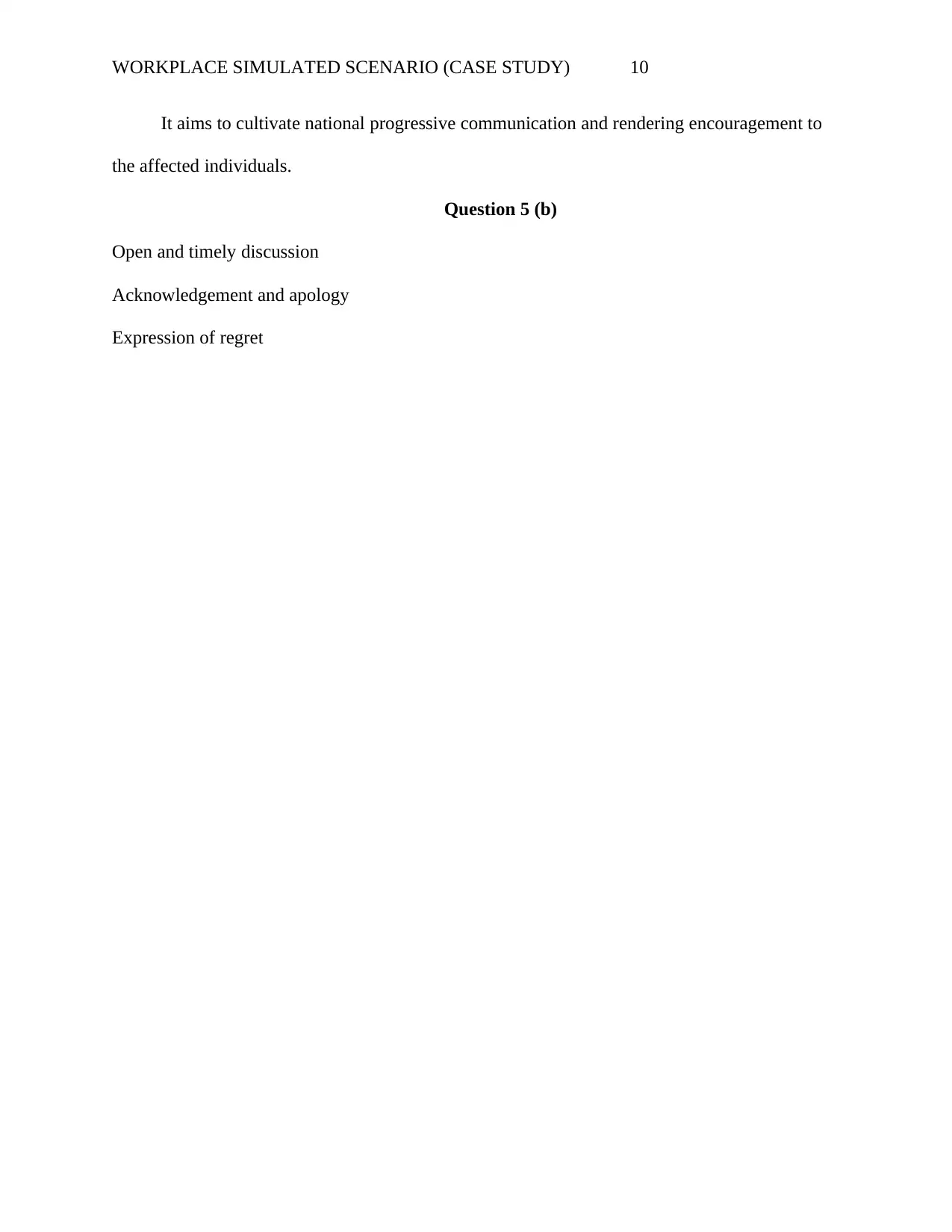
WORKPLACE SIMULATED SCENARIO (CASE STUDY) 10
It aims to cultivate national progressive communication and rendering encouragement to
the affected individuals.
Question 5 (b)
Open and timely discussion
Acknowledgement and apology
Expression of regret
It aims to cultivate national progressive communication and rendering encouragement to
the affected individuals.
Question 5 (b)
Open and timely discussion
Acknowledgement and apology
Expression of regret
Secure Best Marks with AI Grader
Need help grading? Try our AI Grader for instant feedback on your assignments.
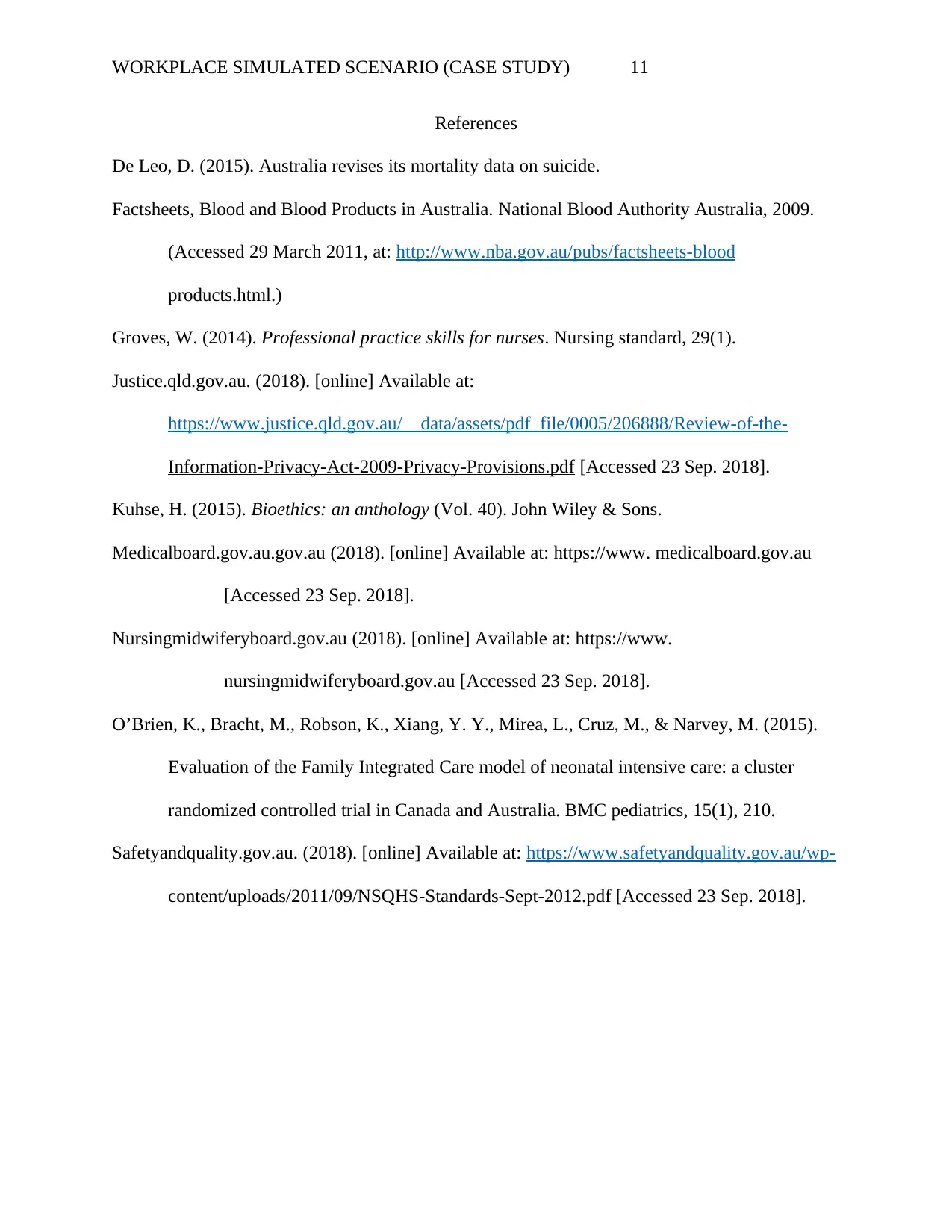
WORKPLACE SIMULATED SCENARIO (CASE STUDY) 11
References
De Leo, D. (2015). Australia revises its mortality data on suicide.
Factsheets, Blood and Blood Products in Australia. National Blood Authority Australia, 2009.
(Accessed 29 March 2011, at: http://www.nba.gov.au/pubs/factsheets-blood
products.html.)
Groves, W. (2014). Professional practice skills for nurses. Nursing standard, 29(1).
Justice.qld.gov.au. (2018). [online] Available at:
https://www.justice.qld.gov.au/__data/assets/pdf_file/0005/206888/Review-of-the-
Information-Privacy-Act-2009-Privacy-Provisions.pdf [Accessed 23 Sep. 2018].
Kuhse, H. (2015). Bioethics: an anthology (Vol. 40). John Wiley & Sons.
Medicalboard.gov.au.gov.au (2018). [online] Available at: https://www. medicalboard.gov.au
[Accessed 23 Sep. 2018].
Nursingmidwiferyboard.gov.au (2018). [online] Available at: https://www.
nursingmidwiferyboard.gov.au [Accessed 23 Sep. 2018].
O’Brien, K., Bracht, M., Robson, K., Xiang, Y. Y., Mirea, L., Cruz, M., & Narvey, M. (2015).
Evaluation of the Family Integrated Care model of neonatal intensive care: a cluster
randomized controlled trial in Canada and Australia. BMC pediatrics, 15(1), 210.
Safetyandquality.gov.au. (2018). [online] Available at: https://www.safetyandquality.gov.au/wp-
content/uploads/2011/09/NSQHS-Standards-Sept-2012.pdf [Accessed 23 Sep. 2018].
References
De Leo, D. (2015). Australia revises its mortality data on suicide.
Factsheets, Blood and Blood Products in Australia. National Blood Authority Australia, 2009.
(Accessed 29 March 2011, at: http://www.nba.gov.au/pubs/factsheets-blood
products.html.)
Groves, W. (2014). Professional practice skills for nurses. Nursing standard, 29(1).
Justice.qld.gov.au. (2018). [online] Available at:
https://www.justice.qld.gov.au/__data/assets/pdf_file/0005/206888/Review-of-the-
Information-Privacy-Act-2009-Privacy-Provisions.pdf [Accessed 23 Sep. 2018].
Kuhse, H. (2015). Bioethics: an anthology (Vol. 40). John Wiley & Sons.
Medicalboard.gov.au.gov.au (2018). [online] Available at: https://www. medicalboard.gov.au
[Accessed 23 Sep. 2018].
Nursingmidwiferyboard.gov.au (2018). [online] Available at: https://www.
nursingmidwiferyboard.gov.au [Accessed 23 Sep. 2018].
O’Brien, K., Bracht, M., Robson, K., Xiang, Y. Y., Mirea, L., Cruz, M., & Narvey, M. (2015).
Evaluation of the Family Integrated Care model of neonatal intensive care: a cluster
randomized controlled trial in Canada and Australia. BMC pediatrics, 15(1), 210.
Safetyandquality.gov.au. (2018). [online] Available at: https://www.safetyandquality.gov.au/wp-
content/uploads/2011/09/NSQHS-Standards-Sept-2012.pdf [Accessed 23 Sep. 2018].
1 out of 11
Your All-in-One AI-Powered Toolkit for Academic Success.
+13062052269
info@desklib.com
Available 24*7 on WhatsApp / Email
![[object Object]](/_next/static/media/star-bottom.7253800d.svg)
Unlock your academic potential
© 2024 | Zucol Services PVT LTD | All rights reserved.


